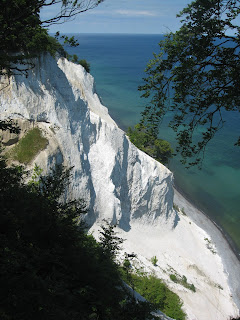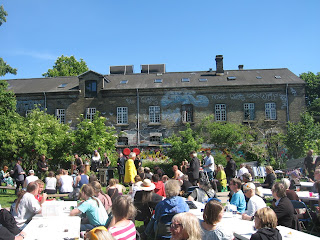Having scrapped through the bridge at the southern tip of
the big island of Funen we anchored off the pretty town of Vordingborg, one of
Denmarks oldest and historic towns with remnants of a medieval castle.
 The next day we woke to a wonderful easterly wind, we would
have it behind us, time to do some miles. We lifted the anchor and headed west.
Heading for the next large island of Funen we stopped on route at the tiny
island of Vejro, once populated by a small farming community it now caters only
for and handful of tourist and a few passing yachts, very laid back and a lovely place to walk around.
The next day we woke to a wonderful easterly wind, we would
have it behind us, time to do some miles. We lifted the anchor and headed west.
Heading for the next large island of Funen we stopped on route at the tiny
island of Vejro, once populated by a small farming community it now caters only
for and handful of tourist and a few passing yachts, very laid back and a lovely place to walk around.
On the way back we came across this rather super fellow.
 Not bad eating, very mackerel like but one extraordinary feature
was that his bones were electric greeny blue! This is said to be as a result of
the biliverdin in the fish, ‘ a green bile pigment also responsible for the
greenish colour sometimes seen in bruises’ – well, there you go!
Not bad eating, very mackerel like but one extraordinary feature
was that his bones were electric greeny blue! This is said to be as a result of
the biliverdin in the fish, ‘ a green bile pigment also responsible for the
greenish colour sometimes seen in bruises’ – well, there you go!
The winds gave up on us after a few hours and we motored the
final miles into Svenborg on the southern tip of Funen.
 A new town on a new island; time for another bike ride with
a rather striking discovery. We were riding up a long hill out of town when we were flashed at by this sign. We were doing 14 kmph and the sign seemed to think that we were going at a snails pace - well we only had little bikes!
A new town on a new island; time for another bike ride with
a rather striking discovery. We were riding up a long hill out of town when we were flashed at by this sign. We were doing 14 kmph and the sign seemed to think that we were going at a snails pace - well we only had little bikes!
The photos a little out of focus but you get the gist. Damned cheek.
On the way home we passed this rather wonderful refurbished wind mill.
The following day we left Svenborg on a fine but blustery
day heading for the small outer islands of Zeeland. Crossing something of an
inland sea surrounded on all sides by islands none of which were higher than
100’ above sea level the water was shallow; the routes however are well marked by
channel markers, the colour and shape of which tell you which side to pass to
keep in the channel.
Even in June these waters are getting busy. After an hour
or so we entered a particularly shallow and narrow channel. Coming the opposite
way was one of many ferries running between the islands. Although in theory we
had right of way over him because we were sailing I kept right to the edge of
the channel to give him all the room I could, after all he was a lot bigger
than me! He was quickly followed by another yacht to whome we gave way pushing
us very close to the downwind side of the channel.
If it got too shallow I had a fallback plan in that I have a lifting
kee. If it gets too tight, at the press of a button I can lift my keel and
reduce my draft but I need it fully down to sail close to the wind properly.
Whilst all this busyness was going on I was struggling to identify the next
marker post. I could see it but I could not make out its colour and its shaped
top was missing; I didn’t know which side to pass. Hedging my bets I decided to
head straight for it for a last minute decision if which side to pass became
clear or at least hugging it so close that I would get away with passing either
side on the grounds that they wouldn’t cut the marking of the channel too fine.
As I got close to the post it started to get really shallow. 3.2 metres, I draw 3.0 metres
with the keel right down, it was time to lift the keel up a bit. I pressed the
button – nothing. Oh dear. 3.1 metres. Press again – nothing - 3.0 metres. We were
healing, that would make us draw a little less, 2.9 metres. Still no idea which
side of the post to go. 2.8 metres. Bang, crunch, grind, oops, we had found the
bottom of the Baltic and it didn’t sound like it was mud! Happily the keel can
just kick up or it would be very dangerous hitting the bottom which would bring
us to an instant stop. However, now we had a problem.
Still nothing when I
tried to lift the keel. The boat came to a stop pretty quickly. 2.7 metres now
and we were being blown down wind and still further out of the channel. Let
go of the sails, start the engine, grab the wheel and try and motor up wind.
The bottom still had a firm hold. If we don’t sort this now I need to get the
anchor out to stop us being blown into even shallower water, One more try on the
keel lift button again, relief, it started to lift. Come on, come on, …. we
were free. The engine powered us forward and we started to edge back towards
the channel but the steering was desperately heavy, had I damaged the rudders
somehow? The rudders draw less than a metre so they should be fine, why was the
steering so heavy? Had we hit something with them? As the boat swung back into
the channel I twigged, I still had the autotomatic steering engaged, I was fighting the steering motor!
Switch it off and all was fine. That was an eye opener, despite how familiar I
was with my boat, with all the action that was going on I didn’t twig that the
steering was being held by the auto helm. Oh well, you live and learn! At that point I also realised that the
reason for the keel not coming up was that sailing close to the wind puts
tremendous sideways pressure on the keel and the lift motor was just not strong enough
to overcome the sideways force. Another learning experience, I will remember
that one in future. Sorry, no pics!
All's well that ends well and an hour later we were anchored
in the shallows of the beautiful island of Aero.
 Aero is a very picturesque island typifying the beauty and
affluence of Denmark , apparently the wealthiest country in the EU measured as
GNP per capita and it certainly shows. Everything is so tidy and perfect; even
the poppies are special! Poppies dotted the fields everywhere adding to the
picturesque atmosphere but this little fellow was rather different – like a
four leafed clover, I don’t think you see many pink poppies! Definitely a good
luck charm for the last week of the first half of the trip (but sadly it didn’t
help with the weather in the days to come).
Aero is a very picturesque island typifying the beauty and
affluence of Denmark , apparently the wealthiest country in the EU measured as
GNP per capita and it certainly shows. Everything is so tidy and perfect; even
the poppies are special! Poppies dotted the fields everywhere adding to the
picturesque atmosphere but this little fellow was rather different – like a
four leafed clover, I don’t think you see many pink poppies! Definitely a good
luck charm for the last week of the first half of the trip (but sadly it didn’t
help with the weather in the days to come).Although the sun has lost its way the winds are now definitely in our favour. They have swung to the north-west giving us fair winds to continue south west and on to Germany. A brisk chilly wind whisked us across the last 20 miles of the Baltic at 7 knots on Tuesday to land us on the German coast at Kappeln, 15 miles north of Kiel, our final destination where we will leave the boat at the beginning of the Kiel canal whilst I go home for a couple of weeks.




























